Financial Burden of Health and Safety Legislation on UK Industries
VerifiedAdded on 2023/03/23
|17
|4867
|67
Essay
AI Summary
This essay examines the financial burden imposed by health and safety legislation on industries. It explores the impact of regulations, such as COSHH and FSO, on businesses, considering both financial and non-financial costs. The essay applies cost-benefit analysis and examines compliance procedures, highlighting the challenges in quantifying costs and benefits. It also considers resilience and expectations approaches to health and safety, the impact on small and large industries, and the importance of long-term perspectives. The analysis includes case studies and theoretical frameworks to evaluate whether health and safety legislation imposes an excessive financial burden, providing a comprehensive overview of the topic.
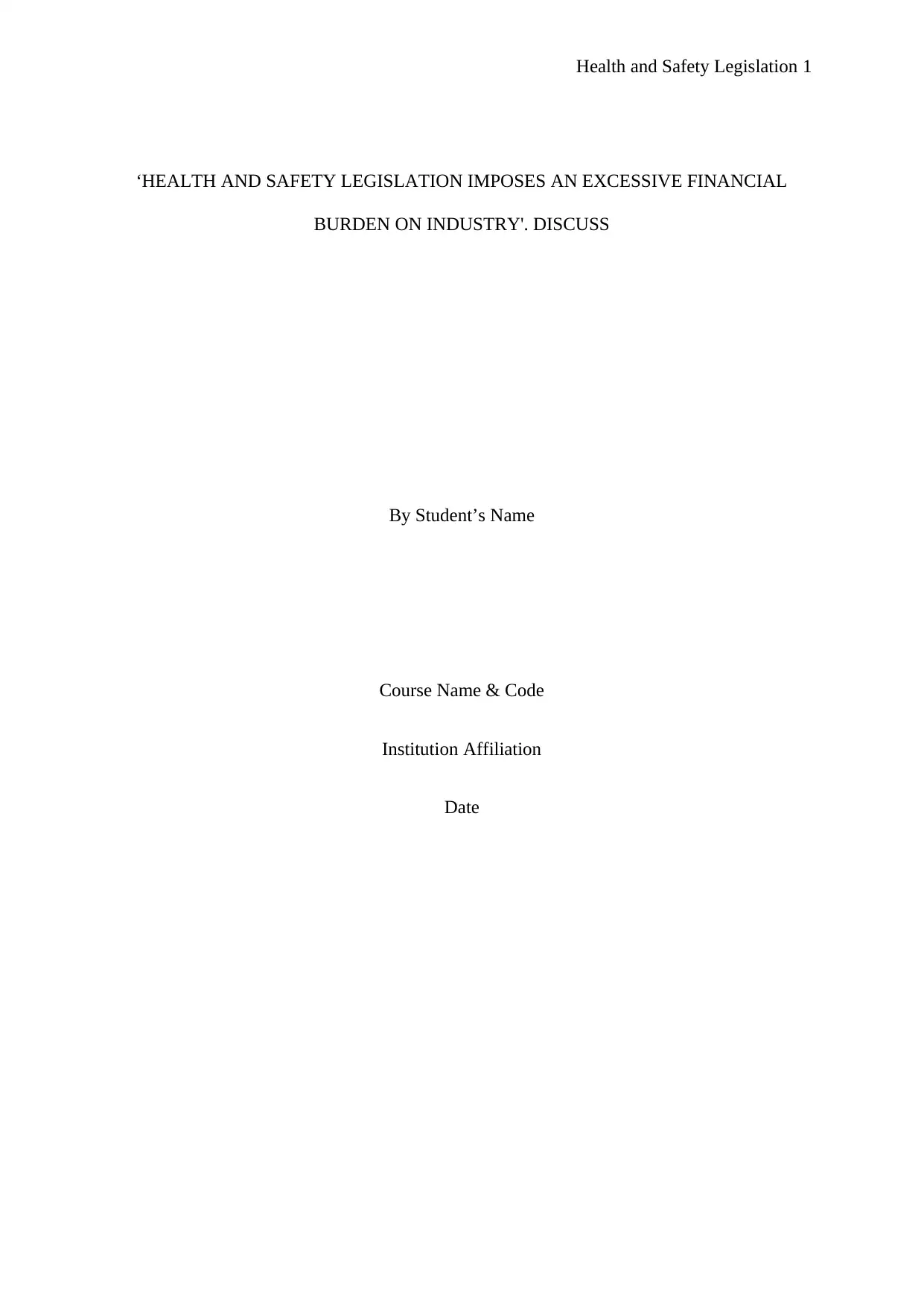
Health and Safety Legislation 1
‘HEALTH AND SAFETY LEGISLATION IMPOSES AN EXCESSIVE FINANCIAL
BURDEN ON INDUSTRY'. DISCUSS
By Student’s Name
Course Name & Code
Institution Affiliation
Date
‘HEALTH AND SAFETY LEGISLATION IMPOSES AN EXCESSIVE FINANCIAL
BURDEN ON INDUSTRY'. DISCUSS
By Student’s Name
Course Name & Code
Institution Affiliation
Date
Paraphrase This Document
Need a fresh take? Get an instant paraphrase of this document with our AI Paraphraser
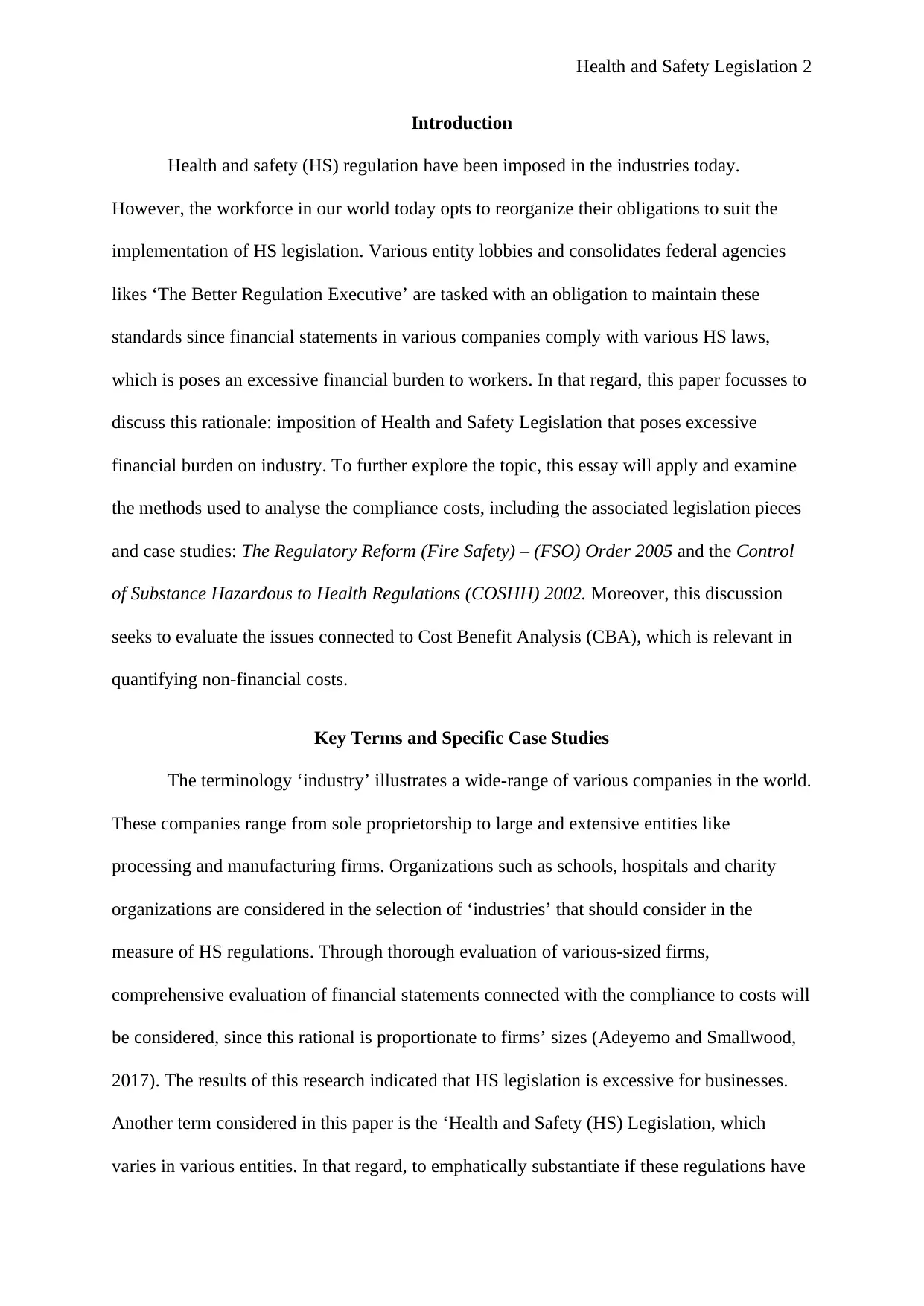
Health and Safety Legislation 2
Introduction
Health and safety (HS) regulation have been imposed in the industries today.
However, the workforce in our world today opts to reorganize their obligations to suit the
implementation of HS legislation. Various entity lobbies and consolidates federal agencies
likes ‘The Better Regulation Executive’ are tasked with an obligation to maintain these
standards since financial statements in various companies comply with various HS laws,
which is poses an excessive financial burden to workers. In that regard, this paper focusses to
discuss this rationale: imposition of Health and Safety Legislation that poses excessive
financial burden on industry. To further explore the topic, this essay will apply and examine
the methods used to analyse the compliance costs, including the associated legislation pieces
and case studies: The Regulatory Reform (Fire Safety) – (FSO) Order 2005 and the Control
of Substance Hazardous to Health Regulations (COSHH) 2002. Moreover, this discussion
seeks to evaluate the issues connected to Cost Benefit Analysis (CBA), which is relevant in
quantifying non-financial costs.
Key Terms and Specific Case Studies
The terminology ‘industry’ illustrates a wide-range of various companies in the world.
These companies range from sole proprietorship to large and extensive entities like
processing and manufacturing firms. Organizations such as schools, hospitals and charity
organizations are considered in the selection of ‘industries’ that should consider in the
measure of HS regulations. Through thorough evaluation of various-sized firms,
comprehensive evaluation of financial statements connected with the compliance to costs will
be considered, since this rational is proportionate to firms’ sizes (Adeyemo and Smallwood,
2017). The results of this research indicated that HS legislation is excessive for businesses.
Another term considered in this paper is the ‘Health and Safety (HS) Legislation, which
varies in various entities. In that regard, to emphatically substantiate if these regulations have
Introduction
Health and safety (HS) regulation have been imposed in the industries today.
However, the workforce in our world today opts to reorganize their obligations to suit the
implementation of HS legislation. Various entity lobbies and consolidates federal agencies
likes ‘The Better Regulation Executive’ are tasked with an obligation to maintain these
standards since financial statements in various companies comply with various HS laws,
which is poses an excessive financial burden to workers. In that regard, this paper focusses to
discuss this rationale: imposition of Health and Safety Legislation that poses excessive
financial burden on industry. To further explore the topic, this essay will apply and examine
the methods used to analyse the compliance costs, including the associated legislation pieces
and case studies: The Regulatory Reform (Fire Safety) – (FSO) Order 2005 and the Control
of Substance Hazardous to Health Regulations (COSHH) 2002. Moreover, this discussion
seeks to evaluate the issues connected to Cost Benefit Analysis (CBA), which is relevant in
quantifying non-financial costs.
Key Terms and Specific Case Studies
The terminology ‘industry’ illustrates a wide-range of various companies in the world.
These companies range from sole proprietorship to large and extensive entities like
processing and manufacturing firms. Organizations such as schools, hospitals and charity
organizations are considered in the selection of ‘industries’ that should consider in the
measure of HS regulations. Through thorough evaluation of various-sized firms,
comprehensive evaluation of financial statements connected with the compliance to costs will
be considered, since this rational is proportionate to firms’ sizes (Adeyemo and Smallwood,
2017). The results of this research indicated that HS legislation is excessive for businesses.
Another term considered in this paper is the ‘Health and Safety (HS) Legislation, which
varies in various entities. In that regard, to emphatically substantiate if these regulations have
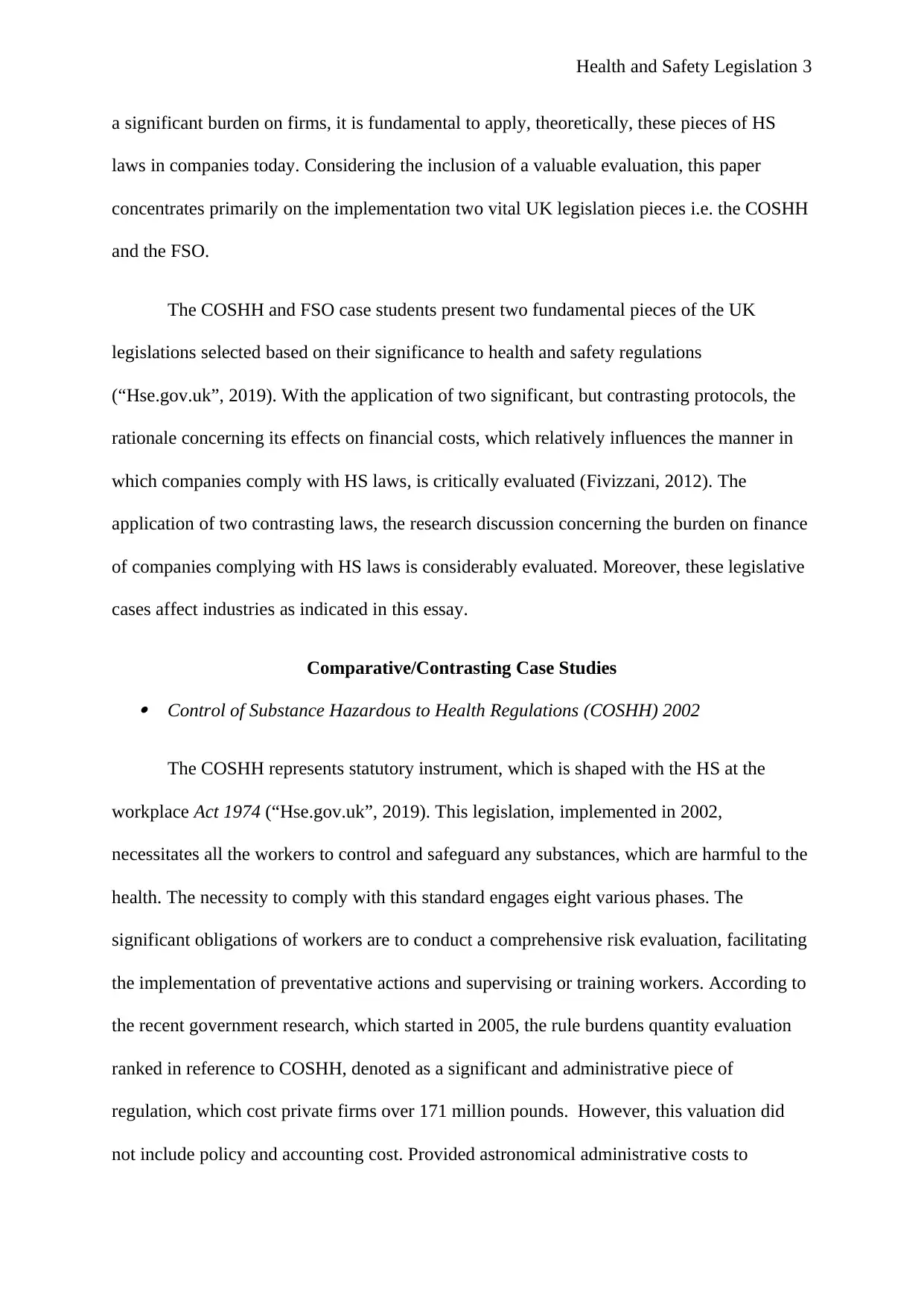
Health and Safety Legislation 3
a significant burden on firms, it is fundamental to apply, theoretically, these pieces of HS
laws in companies today. Considering the inclusion of a valuable evaluation, this paper
concentrates primarily on the implementation two vital UK legislation pieces i.e. the COSHH
and the FSO.
The COSHH and FSO case students present two fundamental pieces of the UK
legislations selected based on their significance to health and safety regulations
(“Hse.gov.uk”, 2019). With the application of two significant, but contrasting protocols, the
rationale concerning its effects on financial costs, which relatively influences the manner in
which companies comply with HS laws, is critically evaluated (Fivizzani, 2012). The
application of two contrasting laws, the research discussion concerning the burden on finance
of companies complying with HS laws is considerably evaluated. Moreover, these legislative
cases affect industries as indicated in this essay.
Comparative/Contrasting Case Studies Control of Substance Hazardous to Health Regulations (COSHH) 2002
The COSHH represents statutory instrument, which is shaped with the HS at the
workplace Act 1974 (“Hse.gov.uk”, 2019). This legislation, implemented in 2002,
necessitates all the workers to control and safeguard any substances, which are harmful to the
health. The necessity to comply with this standard engages eight various phases. The
significant obligations of workers are to conduct a comprehensive risk evaluation, facilitating
the implementation of preventative actions and supervising or training workers. According to
the recent government research, which started in 2005, the rule burdens quantity evaluation
ranked in reference to COSHH, denoted as a significant and administrative piece of
regulation, which cost private firms over 171 million pounds. However, this valuation did
not include policy and accounting cost. Provided astronomical administrative costs to
a significant burden on firms, it is fundamental to apply, theoretically, these pieces of HS
laws in companies today. Considering the inclusion of a valuable evaluation, this paper
concentrates primarily on the implementation two vital UK legislation pieces i.e. the COSHH
and the FSO.
The COSHH and FSO case students present two fundamental pieces of the UK
legislations selected based on their significance to health and safety regulations
(“Hse.gov.uk”, 2019). With the application of two significant, but contrasting protocols, the
rationale concerning its effects on financial costs, which relatively influences the manner in
which companies comply with HS laws, is critically evaluated (Fivizzani, 2012). The
application of two contrasting laws, the research discussion concerning the burden on finance
of companies complying with HS laws is considerably evaluated. Moreover, these legislative
cases affect industries as indicated in this essay.
Comparative/Contrasting Case Studies Control of Substance Hazardous to Health Regulations (COSHH) 2002
The COSHH represents statutory instrument, which is shaped with the HS at the
workplace Act 1974 (“Hse.gov.uk”, 2019). This legislation, implemented in 2002,
necessitates all the workers to control and safeguard any substances, which are harmful to the
health. The necessity to comply with this standard engages eight various phases. The
significant obligations of workers are to conduct a comprehensive risk evaluation, facilitating
the implementation of preventative actions and supervising or training workers. According to
the recent government research, which started in 2005, the rule burdens quantity evaluation
ranked in reference to COSHH, denoted as a significant and administrative piece of
regulation, which cost private firms over 171 million pounds. However, this valuation did
not include policy and accounting cost. Provided astronomical administrative costs to
⊘ This is a preview!⊘
Do you want full access?
Subscribe today to unlock all pages.

Trusted by 1+ million students worldwide
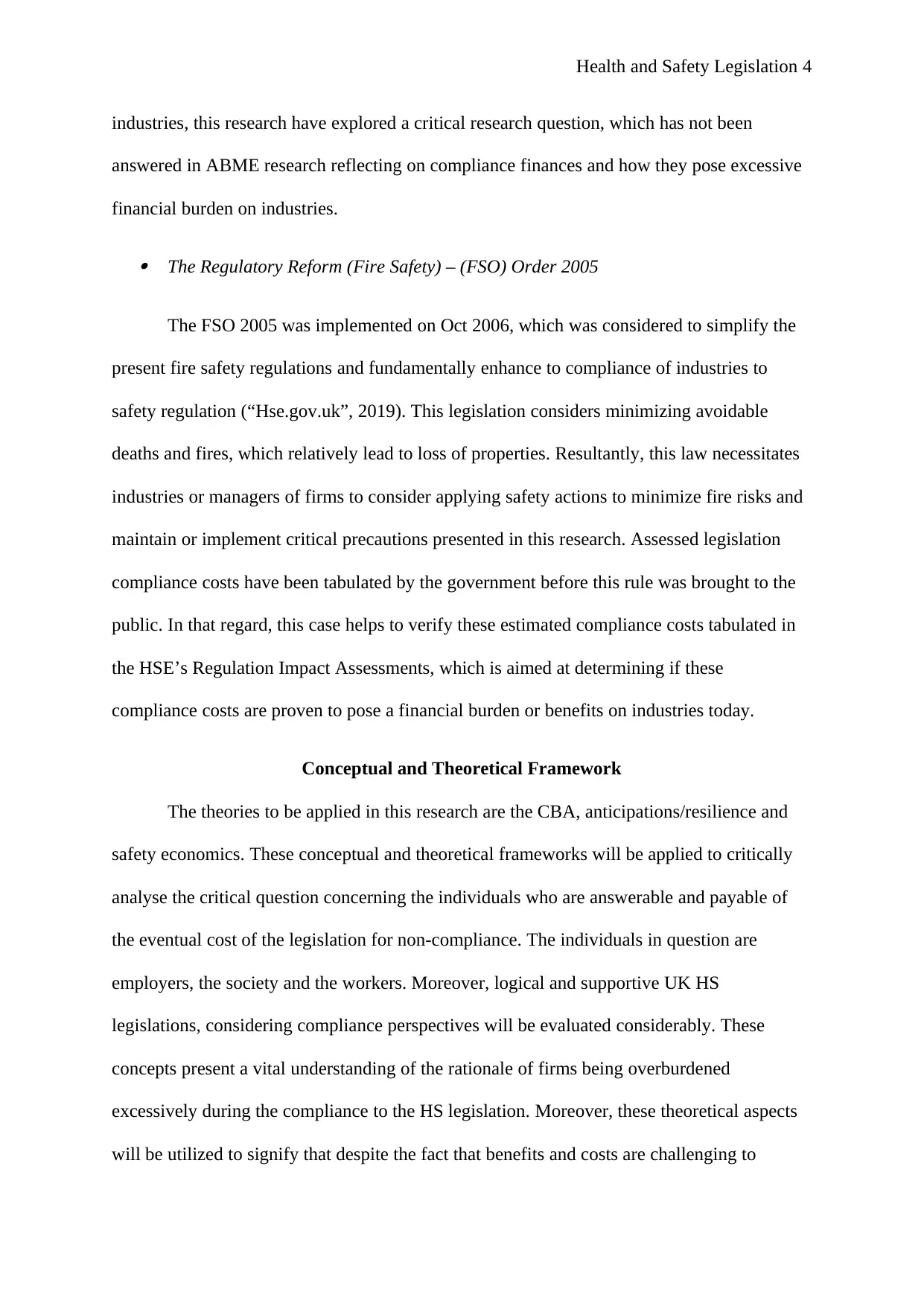
Health and Safety Legislation 4
industries, this research have explored a critical research question, which has not been
answered in ABME research reflecting on compliance finances and how they pose excessive
financial burden on industries.
The Regulatory Reform (Fire Safety) – (FSO) Order 2005
The FSO 2005 was implemented on Oct 2006, which was considered to simplify the
present fire safety regulations and fundamentally enhance to compliance of industries to
safety regulation (“Hse.gov.uk”, 2019). This legislation considers minimizing avoidable
deaths and fires, which relatively lead to loss of properties. Resultantly, this law necessitates
industries or managers of firms to consider applying safety actions to minimize fire risks and
maintain or implement critical precautions presented in this research. Assessed legislation
compliance costs have been tabulated by the government before this rule was brought to the
public. In that regard, this case helps to verify these estimated compliance costs tabulated in
the HSE’s Regulation Impact Assessments, which is aimed at determining if these
compliance costs are proven to pose a financial burden or benefits on industries today.
Conceptual and Theoretical Framework
The theories to be applied in this research are the CBA, anticipations/resilience and
safety economics. These conceptual and theoretical frameworks will be applied to critically
analyse the critical question concerning the individuals who are answerable and payable of
the eventual cost of the legislation for non-compliance. The individuals in question are
employers, the society and the workers. Moreover, logical and supportive UK HS
legislations, considering compliance perspectives will be evaluated considerably. These
concepts present a vital understanding of the rationale of firms being overburdened
excessively during the compliance to the HS legislation. Moreover, these theoretical aspects
will be utilized to signify that despite the fact that benefits and costs are challenging to
industries, this research have explored a critical research question, which has not been
answered in ABME research reflecting on compliance finances and how they pose excessive
financial burden on industries.
The Regulatory Reform (Fire Safety) – (FSO) Order 2005
The FSO 2005 was implemented on Oct 2006, which was considered to simplify the
present fire safety regulations and fundamentally enhance to compliance of industries to
safety regulation (“Hse.gov.uk”, 2019). This legislation considers minimizing avoidable
deaths and fires, which relatively lead to loss of properties. Resultantly, this law necessitates
industries or managers of firms to consider applying safety actions to minimize fire risks and
maintain or implement critical precautions presented in this research. Assessed legislation
compliance costs have been tabulated by the government before this rule was brought to the
public. In that regard, this case helps to verify these estimated compliance costs tabulated in
the HSE’s Regulation Impact Assessments, which is aimed at determining if these
compliance costs are proven to pose a financial burden or benefits on industries today.
Conceptual and Theoretical Framework
The theories to be applied in this research are the CBA, anticipations/resilience and
safety economics. These conceptual and theoretical frameworks will be applied to critically
analyse the critical question concerning the individuals who are answerable and payable of
the eventual cost of the legislation for non-compliance. The individuals in question are
employers, the society and the workers. Moreover, logical and supportive UK HS
legislations, considering compliance perspectives will be evaluated considerably. These
concepts present a vital understanding of the rationale of firms being overburdened
excessively during the compliance to the HS legislation. Moreover, these theoretical aspects
will be utilized to signify that despite the fact that benefits and costs are challenging to
Paraphrase This Document
Need a fresh take? Get an instant paraphrase of this document with our AI Paraphraser
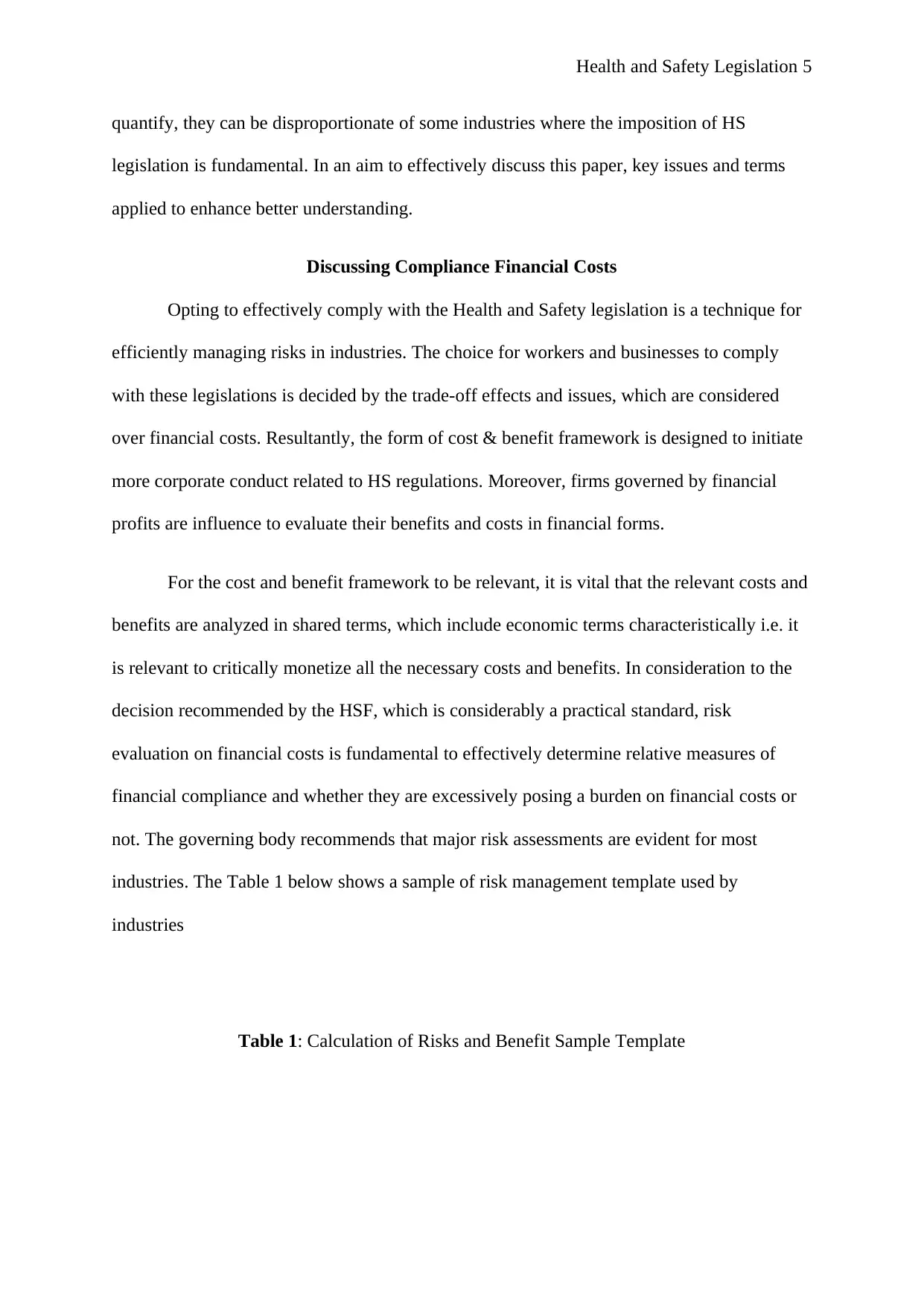
Health and Safety Legislation 5
quantify, they can be disproportionate of some industries where the imposition of HS
legislation is fundamental. In an aim to effectively discuss this paper, key issues and terms
applied to enhance better understanding.
Discussing Compliance Financial Costs
Opting to effectively comply with the Health and Safety legislation is a technique for
efficiently managing risks in industries. The choice for workers and businesses to comply
with these legislations is decided by the trade-off effects and issues, which are considered
over financial costs. Resultantly, the form of cost & benefit framework is designed to initiate
more corporate conduct related to HS regulations. Moreover, firms governed by financial
profits are influence to evaluate their benefits and costs in financial forms.
For the cost and benefit framework to be relevant, it is vital that the relevant costs and
benefits are analyzed in shared terms, which include economic terms characteristically i.e. it
is relevant to critically monetize all the necessary costs and benefits. In consideration to the
decision recommended by the HSF, which is considerably a practical standard, risk
evaluation on financial costs is fundamental to effectively determine relative measures of
financial compliance and whether they are excessively posing a burden on financial costs or
not. The governing body recommends that major risk assessments are evident for most
industries. The Table 1 below shows a sample of risk management template used by
industries
Table 1: Calculation of Risks and Benefit Sample Template
quantify, they can be disproportionate of some industries where the imposition of HS
legislation is fundamental. In an aim to effectively discuss this paper, key issues and terms
applied to enhance better understanding.
Discussing Compliance Financial Costs
Opting to effectively comply with the Health and Safety legislation is a technique for
efficiently managing risks in industries. The choice for workers and businesses to comply
with these legislations is decided by the trade-off effects and issues, which are considered
over financial costs. Resultantly, the form of cost & benefit framework is designed to initiate
more corporate conduct related to HS regulations. Moreover, firms governed by financial
profits are influence to evaluate their benefits and costs in financial forms.
For the cost and benefit framework to be relevant, it is vital that the relevant costs and
benefits are analyzed in shared terms, which include economic terms characteristically i.e. it
is relevant to critically monetize all the necessary costs and benefits. In consideration to the
decision recommended by the HSF, which is considerably a practical standard, risk
evaluation on financial costs is fundamental to effectively determine relative measures of
financial compliance and whether they are excessively posing a burden on financial costs or
not. The governing body recommends that major risk assessments are evident for most
industries. The Table 1 below shows a sample of risk management template used by
industries
Table 1: Calculation of Risks and Benefit Sample Template
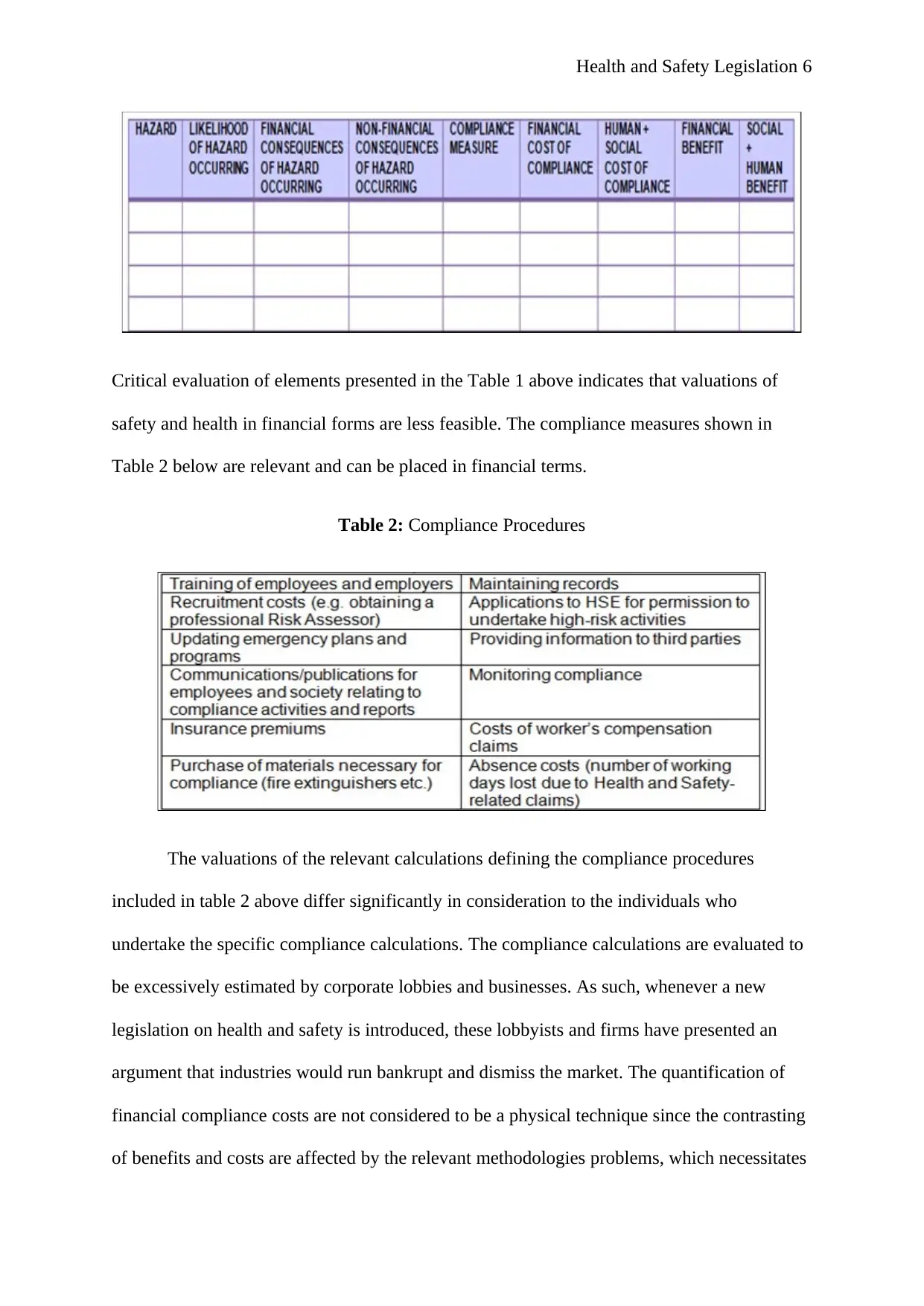
Health and Safety Legislation 6
Critical evaluation of elements presented in the Table 1 above indicates that valuations of
safety and health in financial forms are less feasible. The compliance measures shown in
Table 2 below are relevant and can be placed in financial terms.
Table 2: Compliance Procedures
The valuations of the relevant calculations defining the compliance procedures
included in table 2 above differ significantly in consideration to the individuals who
undertake the specific compliance calculations. The compliance calculations are evaluated to
be excessively estimated by corporate lobbies and businesses. As such, whenever a new
legislation on health and safety is introduced, these lobbyists and firms have presented an
argument that industries would run bankrupt and dismiss the market. The quantification of
financial compliance costs are not considered to be a physical technique since the contrasting
of benefits and costs are affected by the relevant methodologies problems, which necessitates
Critical evaluation of elements presented in the Table 1 above indicates that valuations of
safety and health in financial forms are less feasible. The compliance measures shown in
Table 2 below are relevant and can be placed in financial terms.
Table 2: Compliance Procedures
The valuations of the relevant calculations defining the compliance procedures
included in table 2 above differ significantly in consideration to the individuals who
undertake the specific compliance calculations. The compliance calculations are evaluated to
be excessively estimated by corporate lobbies and businesses. As such, whenever a new
legislation on health and safety is introduced, these lobbyists and firms have presented an
argument that industries would run bankrupt and dismiss the market. The quantification of
financial compliance costs are not considered to be a physical technique since the contrasting
of benefits and costs are affected by the relevant methodologies problems, which necessitates
⊘ This is a preview!⊘
Do you want full access?
Subscribe today to unlock all pages.

Trusted by 1+ million students worldwide
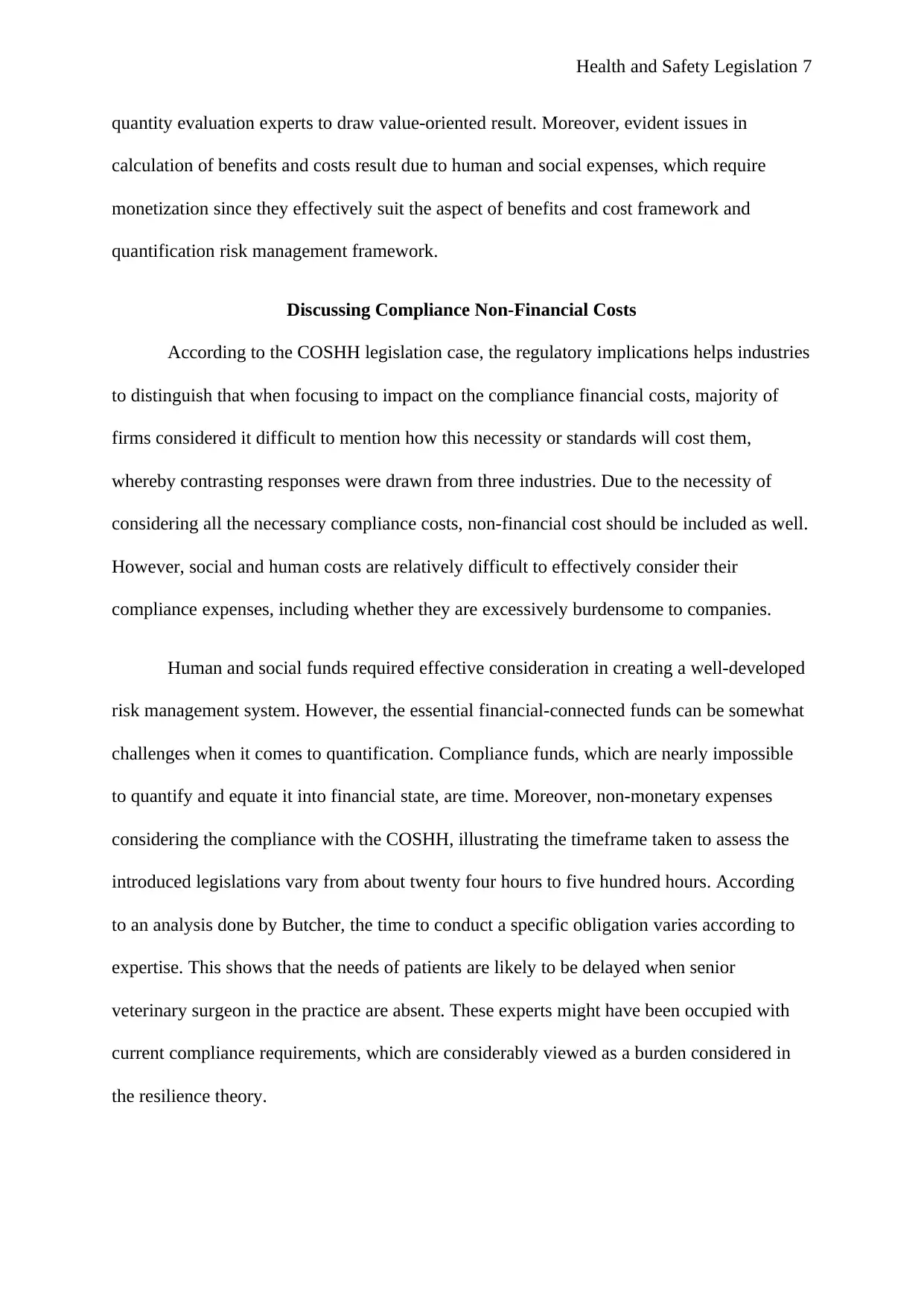
Health and Safety Legislation 7
quantity evaluation experts to draw value-oriented result. Moreover, evident issues in
calculation of benefits and costs result due to human and social expenses, which require
monetization since they effectively suit the aspect of benefits and cost framework and
quantification risk management framework.
Discussing Compliance Non-Financial Costs
According to the COSHH legislation case, the regulatory implications helps industries
to distinguish that when focusing to impact on the compliance financial costs, majority of
firms considered it difficult to mention how this necessity or standards will cost them,
whereby contrasting responses were drawn from three industries. Due to the necessity of
considering all the necessary compliance costs, non-financial cost should be included as well.
However, social and human costs are relatively difficult to effectively consider their
compliance expenses, including whether they are excessively burdensome to companies.
Human and social funds required effective consideration in creating a well-developed
risk management system. However, the essential financial-connected funds can be somewhat
challenges when it comes to quantification. Compliance funds, which are nearly impossible
to quantify and equate it into financial state, are time. Moreover, non-monetary expenses
considering the compliance with the COSHH, illustrating the timeframe taken to assess the
introduced legislations vary from about twenty four hours to five hundred hours. According
to an analysis done by Butcher, the time to conduct a specific obligation varies according to
expertise. This shows that the needs of patients are likely to be delayed when senior
veterinary surgeon in the practice are absent. These experts might have been occupied with
current compliance requirements, which are considerably viewed as a burden considered in
the resilience theory.
quantity evaluation experts to draw value-oriented result. Moreover, evident issues in
calculation of benefits and costs result due to human and social expenses, which require
monetization since they effectively suit the aspect of benefits and cost framework and
quantification risk management framework.
Discussing Compliance Non-Financial Costs
According to the COSHH legislation case, the regulatory implications helps industries
to distinguish that when focusing to impact on the compliance financial costs, majority of
firms considered it difficult to mention how this necessity or standards will cost them,
whereby contrasting responses were drawn from three industries. Due to the necessity of
considering all the necessary compliance costs, non-financial cost should be included as well.
However, social and human costs are relatively difficult to effectively consider their
compliance expenses, including whether they are excessively burdensome to companies.
Human and social funds required effective consideration in creating a well-developed
risk management system. However, the essential financial-connected funds can be somewhat
challenges when it comes to quantification. Compliance funds, which are nearly impossible
to quantify and equate it into financial state, are time. Moreover, non-monetary expenses
considering the compliance with the COSHH, illustrating the timeframe taken to assess the
introduced legislations vary from about twenty four hours to five hundred hours. According
to an analysis done by Butcher, the time to conduct a specific obligation varies according to
expertise. This shows that the needs of patients are likely to be delayed when senior
veterinary surgeon in the practice are absent. These experts might have been occupied with
current compliance requirements, which are considerably viewed as a burden considered in
the resilience theory.
Paraphrase This Document
Need a fresh take? Get an instant paraphrase of this document with our AI Paraphraser
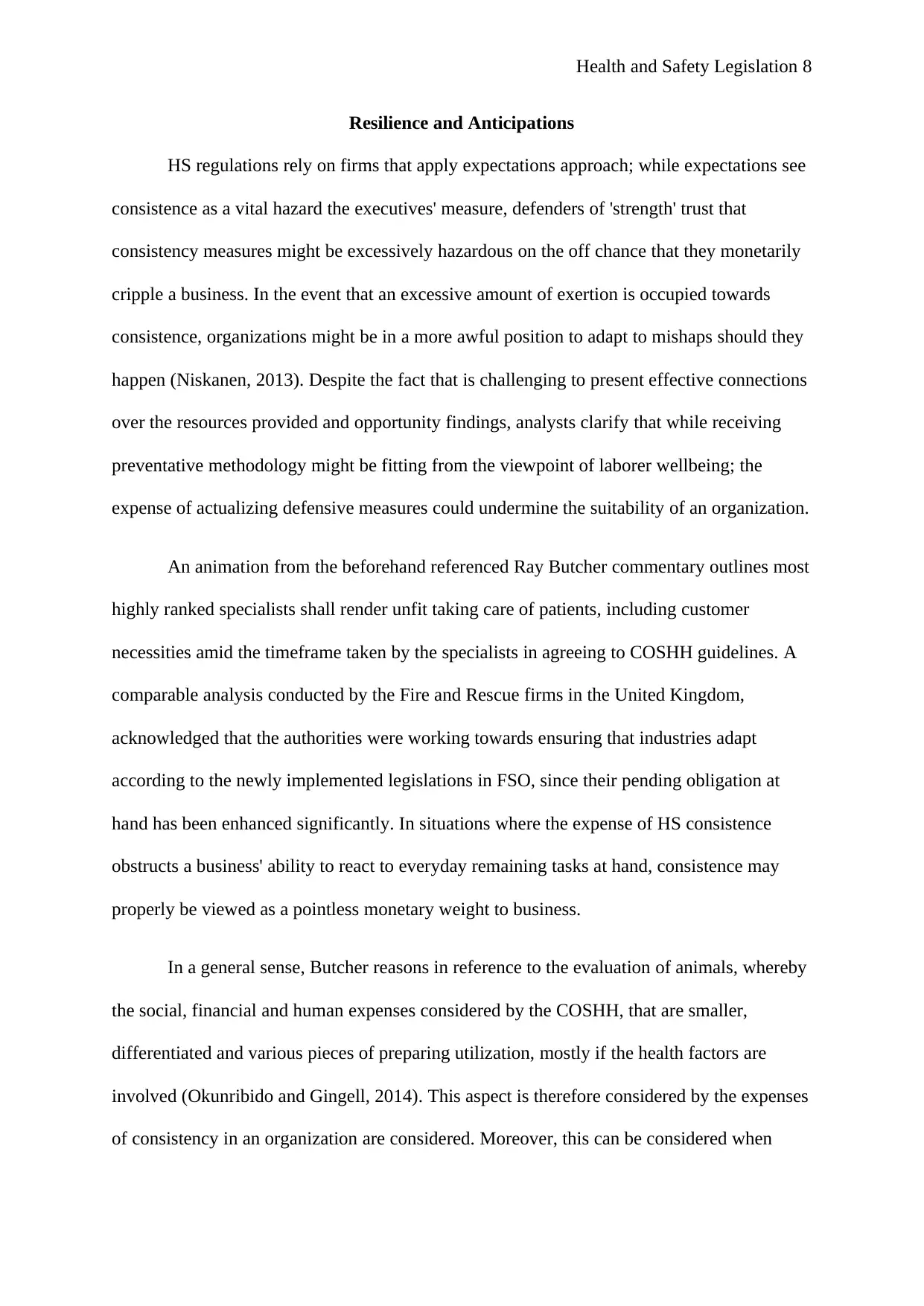
Health and Safety Legislation 8
Resilience and Anticipations
HS regulations rely on firms that apply expectations approach; while expectations see
consistence as a vital hazard the executives' measure, defenders of 'strength' trust that
consistency measures might be excessively hazardous on the off chance that they monetarily
cripple a business. In the event that an excessive amount of exertion is occupied towards
consistence, organizations might be in a more awful position to adapt to mishaps should they
happen (Niskanen, 2013). Despite the fact that is challenging to present effective connections
over the resources provided and opportunity findings, analysts clarify that while receiving
preventative methodology might be fitting from the viewpoint of laborer wellbeing; the
expense of actualizing defensive measures could undermine the suitability of an organization.
An animation from the beforehand referenced Ray Butcher commentary outlines most
highly ranked specialists shall render unfit taking care of patients, including customer
necessities amid the timeframe taken by the specialists in agreeing to COSHH guidelines. A
comparable analysis conducted by the Fire and Rescue firms in the United Kingdom,
acknowledged that the authorities were working towards ensuring that industries adapt
according to the newly implemented legislations in FSO, since their pending obligation at
hand has been enhanced significantly. In situations where the expense of HS consistence
obstructs a business' ability to react to everyday remaining tasks at hand, consistence may
properly be viewed as a pointless monetary weight to business.
In a general sense, Butcher reasons in reference to the evaluation of animals, whereby
the social, financial and human expenses considered by the COSHH, that are smaller,
differentiated and various pieces of preparing utilization, mostly if the health factors are
involved (Okunribido and Gingell, 2014). This aspect is therefore considered by the expenses
of consistency in an organization are considered. Moreover, this can be considered when
Resilience and Anticipations
HS regulations rely on firms that apply expectations approach; while expectations see
consistence as a vital hazard the executives' measure, defenders of 'strength' trust that
consistency measures might be excessively hazardous on the off chance that they monetarily
cripple a business. In the event that an excessive amount of exertion is occupied towards
consistence, organizations might be in a more awful position to adapt to mishaps should they
happen (Niskanen, 2013). Despite the fact that is challenging to present effective connections
over the resources provided and opportunity findings, analysts clarify that while receiving
preventative methodology might be fitting from the viewpoint of laborer wellbeing; the
expense of actualizing defensive measures could undermine the suitability of an organization.
An animation from the beforehand referenced Ray Butcher commentary outlines most
highly ranked specialists shall render unfit taking care of patients, including customer
necessities amid the timeframe taken by the specialists in agreeing to COSHH guidelines. A
comparable analysis conducted by the Fire and Rescue firms in the United Kingdom,
acknowledged that the authorities were working towards ensuring that industries adapt
according to the newly implemented legislations in FSO, since their pending obligation at
hand has been enhanced significantly. In situations where the expense of HS consistence
obstructs a business' ability to react to everyday remaining tasks at hand, consistence may
properly be viewed as a pointless monetary weight to business.
In a general sense, Butcher reasons in reference to the evaluation of animals, whereby
the social, financial and human expenses considered by the COSHH, that are smaller,
differentiated and various pieces of preparing utilization, mostly if the health factors are
involved (Okunribido and Gingell, 2014). This aspect is therefore considered by the expenses
of consistency in an organization are considered. Moreover, this can be considered when
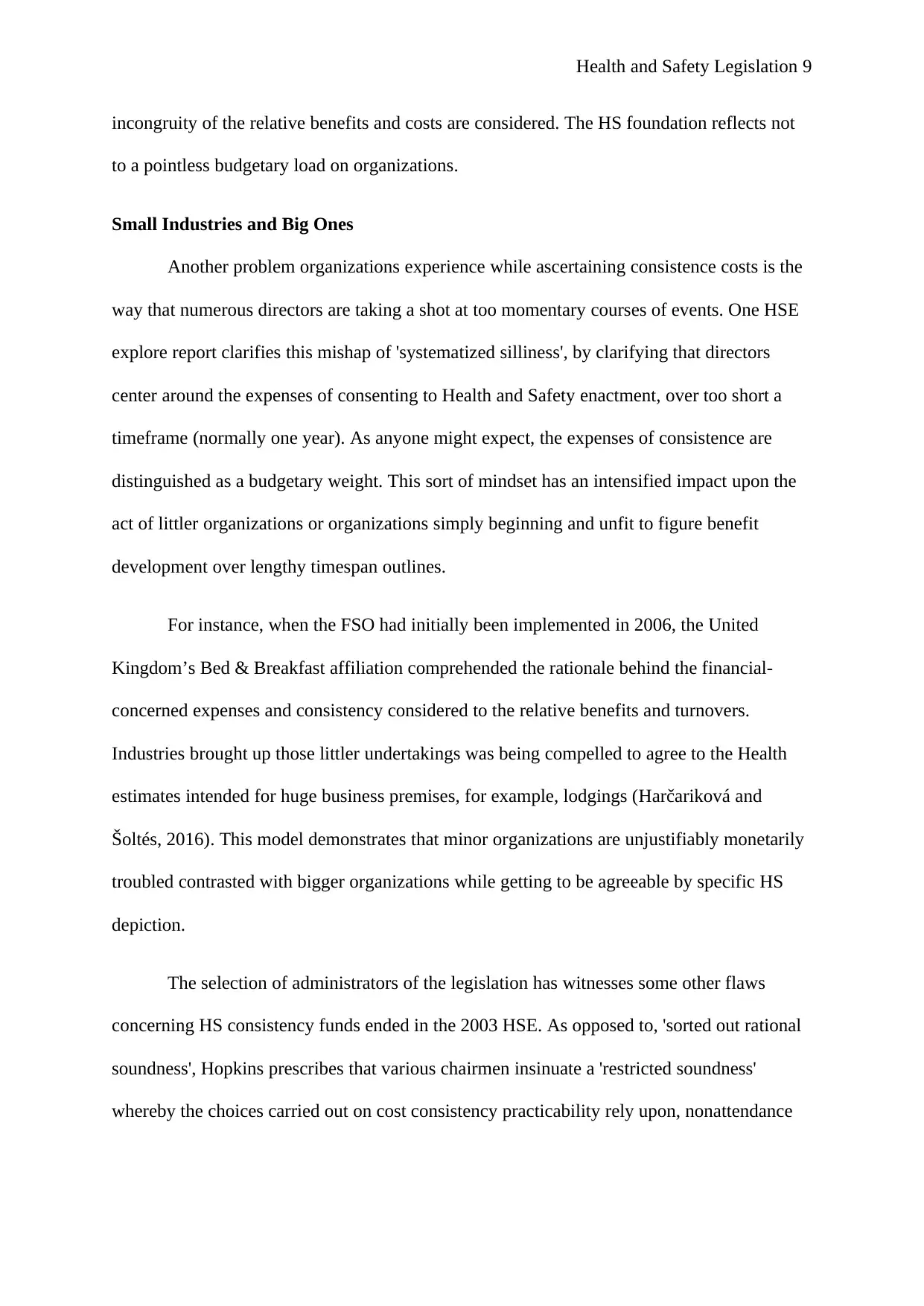
Health and Safety Legislation 9
incongruity of the relative benefits and costs are considered. The HS foundation reflects not
to a pointless budgetary load on organizations.
Small Industries and Big Ones
Another problem organizations experience while ascertaining consistence costs is the
way that numerous directors are taking a shot at too momentary courses of events. One HSE
explore report clarifies this mishap of 'systematized silliness', by clarifying that directors
center around the expenses of consenting to Health and Safety enactment, over too short a
timeframe (normally one year). As anyone might expect, the expenses of consistence are
distinguished as a budgetary weight. This sort of mindset has an intensified impact upon the
act of littler organizations or organizations simply beginning and unfit to figure benefit
development over lengthy timespan outlines.
For instance, when the FSO had initially been implemented in 2006, the United
Kingdom’s Bed & Breakfast affiliation comprehended the rationale behind the financial-
concerned expenses and consistency considered to the relative benefits and turnovers.
Industries brought up those littler undertakings was being compelled to agree to the Health
estimates intended for huge business premises, for example, lodgings (Harčariková and
Šoltés, 2016). This model demonstrates that minor organizations are unjustifiably monetarily
troubled contrasted with bigger organizations while getting to be agreeable by specific HS
depiction.
The selection of administrators of the legislation has witnesses some other flaws
concerning HS consistency funds ended in the 2003 HSE. As opposed to, 'sorted out rational
soundness', Hopkins prescribes that various chairmen insinuate a 'restricted soundness'
whereby the choices carried out on cost consistency practicability rely upon, nonattendance
incongruity of the relative benefits and costs are considered. The HS foundation reflects not
to a pointless budgetary load on organizations.
Small Industries and Big Ones
Another problem organizations experience while ascertaining consistence costs is the
way that numerous directors are taking a shot at too momentary courses of events. One HSE
explore report clarifies this mishap of 'systematized silliness', by clarifying that directors
center around the expenses of consenting to Health and Safety enactment, over too short a
timeframe (normally one year). As anyone might expect, the expenses of consistence are
distinguished as a budgetary weight. This sort of mindset has an intensified impact upon the
act of littler organizations or organizations simply beginning and unfit to figure benefit
development over lengthy timespan outlines.
For instance, when the FSO had initially been implemented in 2006, the United
Kingdom’s Bed & Breakfast affiliation comprehended the rationale behind the financial-
concerned expenses and consistency considered to the relative benefits and turnovers.
Industries brought up those littler undertakings was being compelled to agree to the Health
estimates intended for huge business premises, for example, lodgings (Harčariková and
Šoltés, 2016). This model demonstrates that minor organizations are unjustifiably monetarily
troubled contrasted with bigger organizations while getting to be agreeable by specific HS
depiction.
The selection of administrators of the legislation has witnesses some other flaws
concerning HS consistency funds ended in the 2003 HSE. As opposed to, 'sorted out rational
soundness', Hopkins prescribes that various chairmen insinuate a 'restricted soundness'
whereby the choices carried out on cost consistency practicability rely upon, nonattendance
⊘ This is a preview!⊘
Do you want full access?
Subscribe today to unlock all pages.

Trusted by 1+ million students worldwide
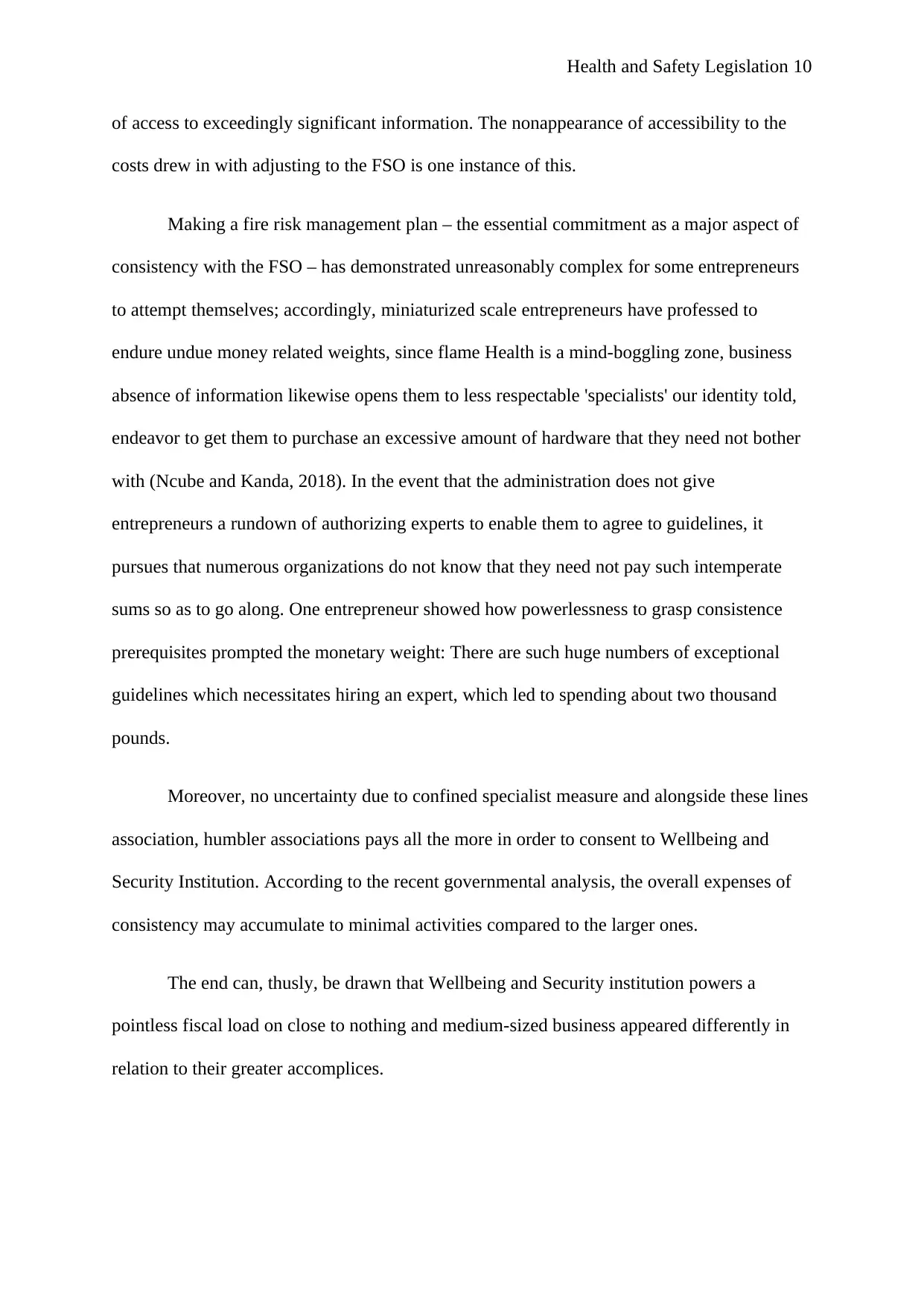
Health and Safety Legislation 10
of access to exceedingly significant information. The nonappearance of accessibility to the
costs drew in with adjusting to the FSO is one instance of this.
Making a fire risk management plan – the essential commitment as a major aspect of
consistency with the FSO – has demonstrated unreasonably complex for some entrepreneurs
to attempt themselves; accordingly, miniaturized scale entrepreneurs have professed to
endure undue money related weights, since flame Health is a mind-boggling zone, business
absence of information likewise opens them to less respectable 'specialists' our identity told,
endeavor to get them to purchase an excessive amount of hardware that they need not bother
with (Ncube and Kanda, 2018). In the event that the administration does not give
entrepreneurs a rundown of authorizing experts to enable them to agree to guidelines, it
pursues that numerous organizations do not know that they need not pay such intemperate
sums so as to go along. One entrepreneur showed how powerlessness to grasp consistence
prerequisites prompted the monetary weight: There are such huge numbers of exceptional
guidelines which necessitates hiring an expert, which led to spending about two thousand
pounds.
Moreover, no uncertainty due to confined specialist measure and alongside these lines
association, humbler associations pays all the more in order to consent to Wellbeing and
Security Institution. According to the recent governmental analysis, the overall expenses of
consistency may accumulate to minimal activities compared to the larger ones.
The end can, thusly, be drawn that Wellbeing and Security institution powers a
pointless fiscal load on close to nothing and medium-sized business appeared differently in
relation to their greater accomplices.
of access to exceedingly significant information. The nonappearance of accessibility to the
costs drew in with adjusting to the FSO is one instance of this.
Making a fire risk management plan – the essential commitment as a major aspect of
consistency with the FSO – has demonstrated unreasonably complex for some entrepreneurs
to attempt themselves; accordingly, miniaturized scale entrepreneurs have professed to
endure undue money related weights, since flame Health is a mind-boggling zone, business
absence of information likewise opens them to less respectable 'specialists' our identity told,
endeavor to get them to purchase an excessive amount of hardware that they need not bother
with (Ncube and Kanda, 2018). In the event that the administration does not give
entrepreneurs a rundown of authorizing experts to enable them to agree to guidelines, it
pursues that numerous organizations do not know that they need not pay such intemperate
sums so as to go along. One entrepreneur showed how powerlessness to grasp consistence
prerequisites prompted the monetary weight: There are such huge numbers of exceptional
guidelines which necessitates hiring an expert, which led to spending about two thousand
pounds.
Moreover, no uncertainty due to confined specialist measure and alongside these lines
association, humbler associations pays all the more in order to consent to Wellbeing and
Security Institution. According to the recent governmental analysis, the overall expenses of
consistency may accumulate to minimal activities compared to the larger ones.
The end can, thusly, be drawn that Wellbeing and Security institution powers a
pointless fiscal load on close to nothing and medium-sized business appeared differently in
relation to their greater accomplices.
Paraphrase This Document
Need a fresh take? Get an instant paraphrase of this document with our AI Paraphraser
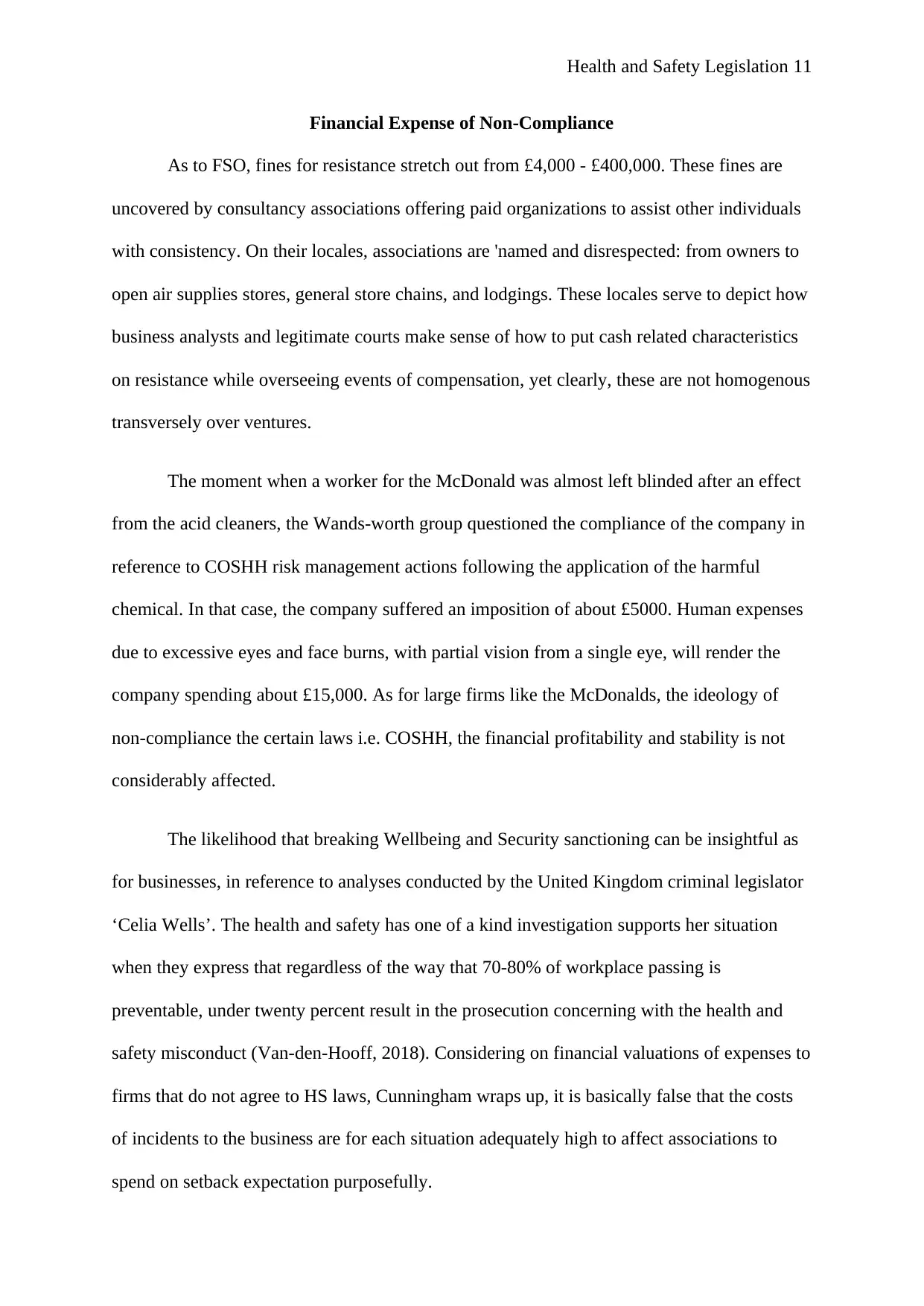
Health and Safety Legislation 11
Financial Expense of Non-Compliance
As to FSO, fines for resistance stretch out from £4,000 - £400,000. These fines are
uncovered by consultancy associations offering paid organizations to assist other individuals
with consistency. On their locales, associations are 'named and disrespected: from owners to
open air supplies stores, general store chains, and lodgings. These locales serve to depict how
business analysts and legitimate courts make sense of how to put cash related characteristics
on resistance while overseeing events of compensation, yet clearly, these are not homogenous
transversely over ventures.
The moment when a worker for the McDonald was almost left blinded after an effect
from the acid cleaners, the Wands-worth group questioned the compliance of the company in
reference to COSHH risk management actions following the application of the harmful
chemical. In that case, the company suffered an imposition of about £5000. Human expenses
due to excessive eyes and face burns, with partial vision from a single eye, will render the
company spending about £15,000. As for large firms like the McDonalds, the ideology of
non-compliance the certain laws i.e. COSHH, the financial profitability and stability is not
considerably affected.
The likelihood that breaking Wellbeing and Security sanctioning can be insightful as
for businesses, in reference to analyses conducted by the United Kingdom criminal legislator
‘Celia Wells’. The health and safety has one of a kind investigation supports her situation
when they express that regardless of the way that 70-80% of workplace passing is
preventable, under twenty percent result in the prosecution concerning with the health and
safety misconduct (Van-den-Hooff, 2018). Considering on financial valuations of expenses to
firms that do not agree to HS laws, Cunningham wraps up, it is basically false that the costs
of incidents to the business are for each situation adequately high to affect associations to
spend on setback expectation purposefully.
Financial Expense of Non-Compliance
As to FSO, fines for resistance stretch out from £4,000 - £400,000. These fines are
uncovered by consultancy associations offering paid organizations to assist other individuals
with consistency. On their locales, associations are 'named and disrespected: from owners to
open air supplies stores, general store chains, and lodgings. These locales serve to depict how
business analysts and legitimate courts make sense of how to put cash related characteristics
on resistance while overseeing events of compensation, yet clearly, these are not homogenous
transversely over ventures.
The moment when a worker for the McDonald was almost left blinded after an effect
from the acid cleaners, the Wands-worth group questioned the compliance of the company in
reference to COSHH risk management actions following the application of the harmful
chemical. In that case, the company suffered an imposition of about £5000. Human expenses
due to excessive eyes and face burns, with partial vision from a single eye, will render the
company spending about £15,000. As for large firms like the McDonalds, the ideology of
non-compliance the certain laws i.e. COSHH, the financial profitability and stability is not
considerably affected.
The likelihood that breaking Wellbeing and Security sanctioning can be insightful as
for businesses, in reference to analyses conducted by the United Kingdom criminal legislator
‘Celia Wells’. The health and safety has one of a kind investigation supports her situation
when they express that regardless of the way that 70-80% of workplace passing is
preventable, under twenty percent result in the prosecution concerning with the health and
safety misconduct (Van-den-Hooff, 2018). Considering on financial valuations of expenses to
firms that do not agree to HS laws, Cunningham wraps up, it is basically false that the costs
of incidents to the business are for each situation adequately high to affect associations to
spend on setback expectation purposefully.
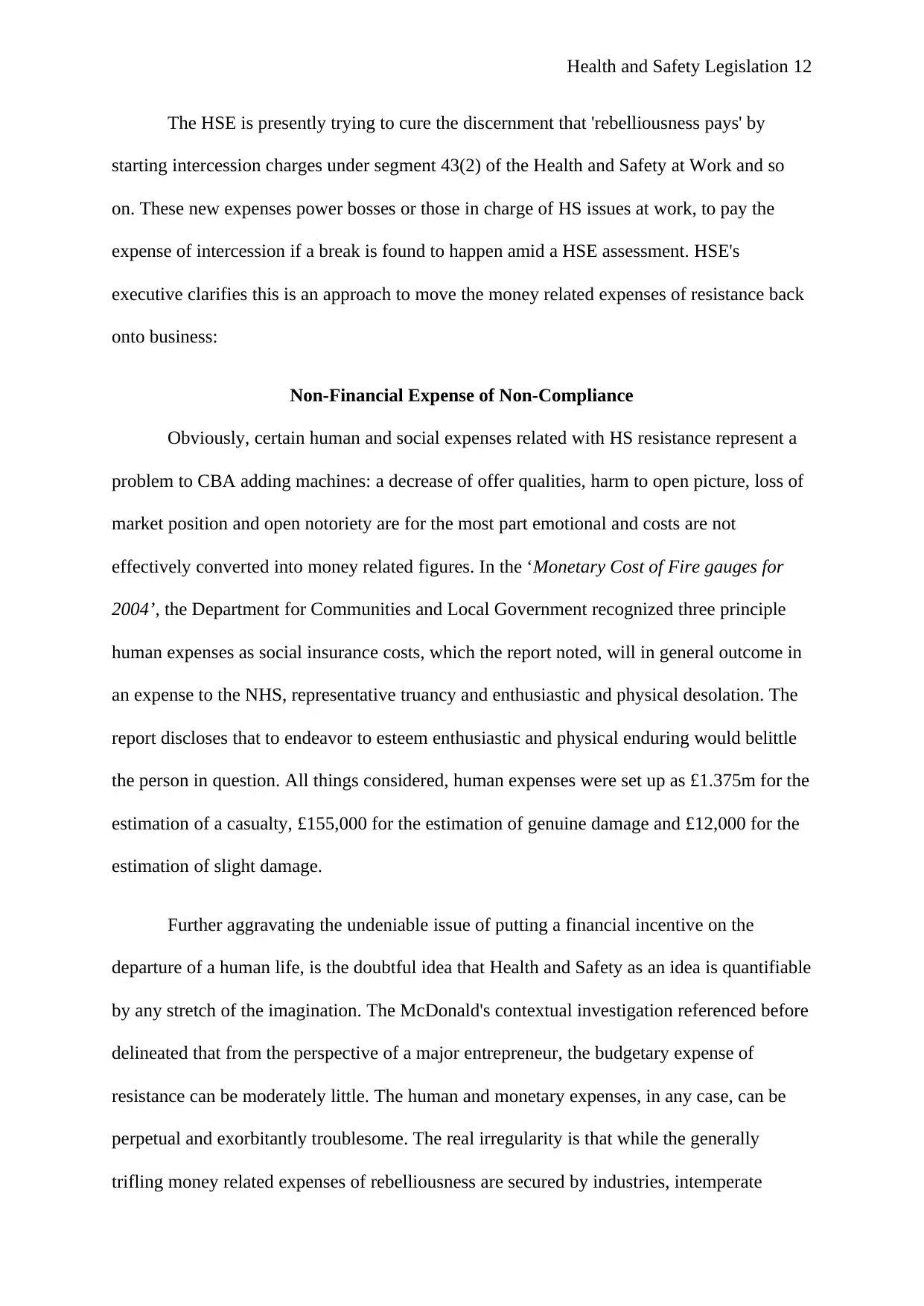
Health and Safety Legislation 12
The HSE is presently trying to cure the discernment that 'rebelliousness pays' by
starting intercession charges under segment 43(2) of the Health and Safety at Work and so
on. These new expenses power bosses or those in charge of HS issues at work, to pay the
expense of intercession if a break is found to happen amid a HSE assessment. HSE's
executive clarifies this is an approach to move the money related expenses of resistance back
onto business:
Non-Financial Expense of Non-Compliance
Obviously, certain human and social expenses related with HS resistance represent a
problem to CBA adding machines: a decrease of offer qualities, harm to open picture, loss of
market position and open notoriety are for the most part emotional and costs are not
effectively converted into money related figures. In the ‘Monetary Cost of Fire gauges for
2004’, the Department for Communities and Local Government recognized three principle
human expenses as social insurance costs, which the report noted, will in general outcome in
an expense to the NHS, representative truancy and enthusiastic and physical desolation. The
report discloses that to endeavor to esteem enthusiastic and physical enduring would belittle
the person in question. All things considered, human expenses were set up as £1.375m for the
estimation of a casualty, £155,000 for the estimation of genuine damage and £12,000 for the
estimation of slight damage.
Further aggravating the undeniable issue of putting a financial incentive on the
departure of a human life, is the doubtful idea that Health and Safety as an idea is quantifiable
by any stretch of the imagination. The McDonald's contextual investigation referenced before
delineated that from the perspective of a major entrepreneur, the budgetary expense of
resistance can be moderately little. The human and monetary expenses, in any case, can be
perpetual and exorbitantly troublesome. The real irregularity is that while the generally
trifling money related expenses of rebelliousness are secured by industries, intemperate
The HSE is presently trying to cure the discernment that 'rebelliousness pays' by
starting intercession charges under segment 43(2) of the Health and Safety at Work and so
on. These new expenses power bosses or those in charge of HS issues at work, to pay the
expense of intercession if a break is found to happen amid a HSE assessment. HSE's
executive clarifies this is an approach to move the money related expenses of resistance back
onto business:
Non-Financial Expense of Non-Compliance
Obviously, certain human and social expenses related with HS resistance represent a
problem to CBA adding machines: a decrease of offer qualities, harm to open picture, loss of
market position and open notoriety are for the most part emotional and costs are not
effectively converted into money related figures. In the ‘Monetary Cost of Fire gauges for
2004’, the Department for Communities and Local Government recognized three principle
human expenses as social insurance costs, which the report noted, will in general outcome in
an expense to the NHS, representative truancy and enthusiastic and physical desolation. The
report discloses that to endeavor to esteem enthusiastic and physical enduring would belittle
the person in question. All things considered, human expenses were set up as £1.375m for the
estimation of a casualty, £155,000 for the estimation of genuine damage and £12,000 for the
estimation of slight damage.
Further aggravating the undeniable issue of putting a financial incentive on the
departure of a human life, is the doubtful idea that Health and Safety as an idea is quantifiable
by any stretch of the imagination. The McDonald's contextual investigation referenced before
delineated that from the perspective of a major entrepreneur, the budgetary expense of
resistance can be moderately little. The human and monetary expenses, in any case, can be
perpetual and exorbitantly troublesome. The real irregularity is that while the generally
trifling money related expenses of rebelliousness are secured by industries, intemperate
⊘ This is a preview!⊘
Do you want full access?
Subscribe today to unlock all pages.

Trusted by 1+ million students worldwide
1 out of 17
Related Documents
Your All-in-One AI-Powered Toolkit for Academic Success.
+13062052269
info@desklib.com
Available 24*7 on WhatsApp / Email
![[object Object]](/_next/static/media/star-bottom.7253800d.svg)
Unlock your academic potential
Copyright © 2020–2025 A2Z Services. All Rights Reserved. Developed and managed by ZUCOL.





